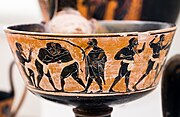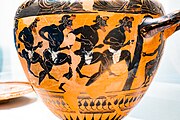
Perizoma (Greek περίζωμα, plural; perizomata) is a type of loincloth that was worn in Ancient Greece. The perizoma was typically worn by manual laborers or athletes. This garment could be worn independently or with a short chiton or even underneath a longer chiton. Homer references the perizoma in his epic, The Illiad underscoring its role in ancient Greek dress.
The perizoma is thought to have originated with the Minoan civilization in Crete. Surviving depictions show it being worn by male and female acrobats (for example, in the Bull-Leaping Fresco).
A perizoma was possibly worn by Jesus during his crucifixion. It is a standard feature of the crucifixion in the arts. However, the Roman custom was to crucify victims naked, and there is no evidence to suggest that Jesus was an exception. Perizoma was likely added by later artists to preserve modesty (see fig leaf) and first appeared in the 8th century. Aachen Cathedral claims to have the actual relic of the perizoma, preserved inside the Marienschrein reliquary.
Etymology
The word perizoma is derived from peri "around, about" and zoma "loin-cloth, drawers, band, belt"
-
 Athletes in perizomata (boxers, wrestlers, runner, jumper, diskobolos, acontist) and draped bearded trainers with switch
Athletes in perizomata (boxers, wrestlers, runner, jumper, diskobolos, acontist) and draped bearded trainers with switch
-
 Bearded Greek athletes in perizomata (boxers, wrestlers, runner, jumper, diskobolos, acontist) and draped bearded trainers
Bearded Greek athletes in perizomata (boxers, wrestlers, runner, jumper, diskobolos, acontist) and draped bearded trainers
-
 Bearded Greek athletes wearing perizomata running
Bearded Greek athletes wearing perizomata running
-
 Christ Crucified by Diego Velázquez shows Jesus wearing a perizoma
Christ Crucified by Diego Velázquez shows Jesus wearing a perizoma
See also
References
- ^ Tortora, Phyllis G.; Eubank, Keith (1994). A Survey of Historic Costume: A History of Western Dress. Fairchild Publications. p. 57. ISBN 978-1-56367-003-9.
- Poliakoff, Michael B. (1987-01-01). Combat Sports in the Ancient World: Competition, Violence, and Culture. Yale University Press. pp. 165–166. ISBN 978-0-300-06312-7.
- Bonfante, Larissa (2003). Etruscan Dress. JHU Press. pp. 19–20. ISBN 9780801874130.
- Condra, Jill (2008). The Greenwood Encyclopedia of Clothing Through World History: Prehistory to 1500CE. Westport, Connecticut: Greenwood Publishing Group. p. 79. ISBN 978-0-313-33662-1. OCLC 156808055.
- Tombs, David (2009). "Prisoner Abuse: From Abu Ghraib to the Passion of the Christ". In Hogan, Linda; Lehrke, Dylan (eds.). Religion and the Politics of Peace and Conflict. Princeton Theological Monograph Series. Wipf and Stock Publishers. pp. 182–83. ISBN 9781556350672.
- Viladesau, Richard (2006). The Beauty of the Cross: The Passion of Christ in Theology and the Arts from the Catacombs to the Eve of the Renaissance. Oxford University Press. p. 188. ISBN 9780195188110.
- Nickell, Joe (2007). Relics of the Christ. University Press of Kentucky. p. 106. ISBN 9780813172125.